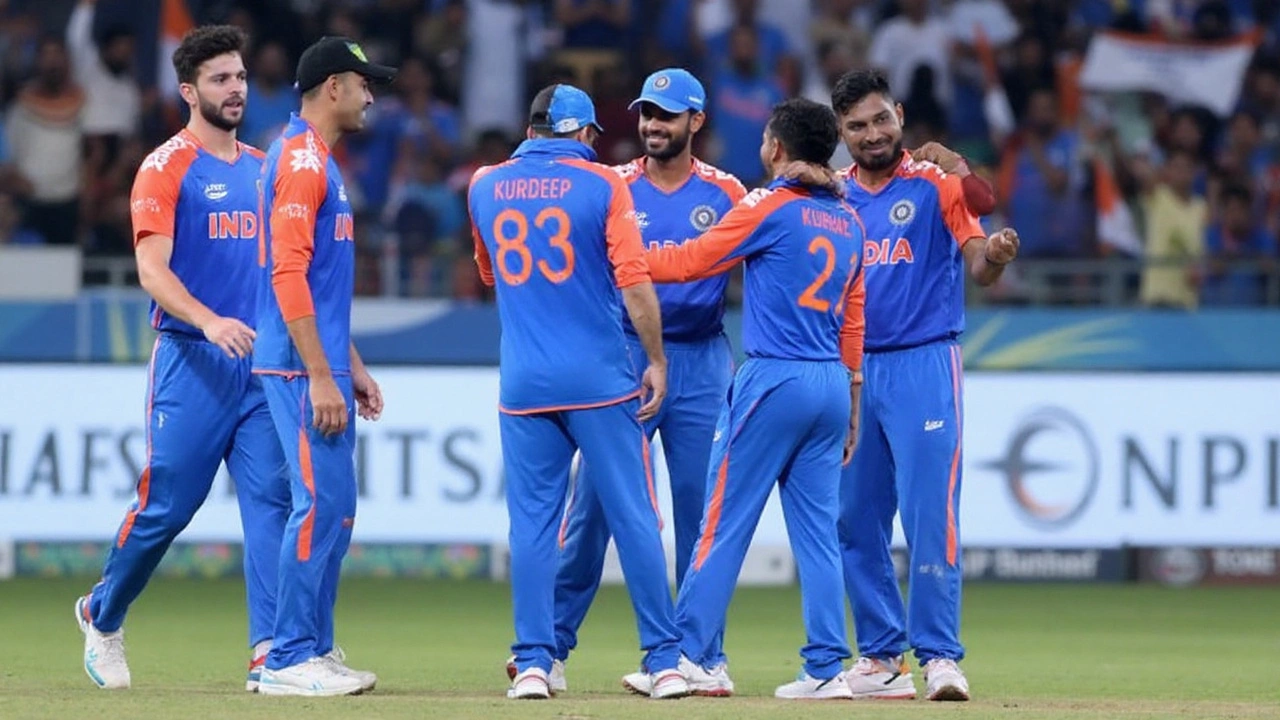By Kiran
Another chapter, same outcome. In a game loaded with noise and nerves, India hunted down 128 with seven wickets to spare in Dubai, turning a tense India vs Pakistan T20 into a tidy display of control. The win, in the 6th match of the Asia Cup 2025, rested on Kuldeep Yadav’s grip over the middle overs and a no-frills chase that wasted little energy.
How the match unfolded
Pakistan batted first and never quite found a rhythm. The surface in Dubai had just enough hold to punish loose shots and reward bowlers who hit the pitch hard. Fakhar Zaman and Saim Ayub tried to set the tone, but dot-ball pressure kept stacking up. The moment spin arrived, the tempo shifted. Kuldeep Yadav worked through the middle with subtle changes of pace and angle, picking three key wickets and shutting down the scoring options square of the wicket.
Pakistan’s captain Salman Ali Agha looked to build around short stands, but partnerships kept stalling. India’s seamers were disciplined upfront, attacking the top of off with cross-seam deliveries and heavy back-of-a-length bowling. The spinners followed that script, and the fielding backed it with tidy ground work on a big outfield where twos usually flow. What Pakistan needed was one anchor and one aggressor; they got neither long enough, and 128 always felt a step light.
India’s reply was clinical. No rush in the powerplay, no panic after a wicket, and plenty of strike rotation once the ball softened. The top order absorbed the new-ball phase, then pushed into gaps, forcing Pakistan’s bowlers to change lines. When spin came on, India used the sweep and the late cut to keep the board moving and avoided the one thing this chase didn’t need—clumps of wickets. A small wobble in the middle—inevitable in a rivalry game—never became a collapse. The finishing kick came with overs in the bank and boundaries taken off anything marginal in length.
The real difference was the game’s tempo. India controlled it. Any time Pakistan threatened to wrestle it back—an over with a dot-ball run, a hint of drift for the spinner—India ticked singles, stole twos, and waited for the drag-down. That’s what good chasing sides do: shrink the chase into small, manageable blocks and keep the asking rate flat.
For Pakistan, this was a night of almosts. The new ball didn’t swing enough to demand false shots. The spinners found some grip but not enough carry to beat both bat and edge. The best chance was to squeeze India through tight fields and patience. India didn’t let them.
- Venue: Dubai International Cricket Stadium
- Date: September 14, 2025
- Pakistan: 128 all out (Kuldeep Yadav took three wickets)
- Result: India won by 7 wickets
The atmosphere delivered as expected. Dubai’s stands had the split colors, the drums, and that hum that never fades, even when the scoring slows. Every misfield drew a groan. Every single taken to a ring fielder drew a cheer. In games like these, control over nerves is as important as control over line and length. India had both.
What it means for both teams
Kuldeep’s spell will get the headlines, and it should. He hit that sweet spot of drift and dip where batters misjudge length even when they read the hand. Right-handers struggled to sweep him cleanly; left-handers couldn’t free their arms through cover. It’s the kind of spell that compresses a T20 innings—no release shots, no easy singles—and it set up everything that followed. India’s support cast did their job around him: seamers kept a tight lid at the start and end, and the other spinner(s) built dots off his pressure.
This result also confirms India’s template for the tournament: disciplined new-ball overs, a spin choke in the middle, and a chase that leans on strike rotation before targeting the short boundary. It’s the same approach that bulldozed UAE earlier in the week and now it has stood up against a stronger attack. The knock-on effect is useful too—points on the board and a gentle bump to net run rate without burning out key players.
Pakistan arrived with confidence after their UAE Tri-Series win, and that mattered—until the first 10 overs of their batting. Once India forced them below the par rate, the innings became reactive. There were flashes—one over here, a clean hit there—but nothing sustained. If they’re to go deep in this tournament, they need cleaner role clarity at the top and a designated middle-overs accelerator who can manufacture boundaries against spin without risking a collapse.
Tactically, Pakistan may revisit their balance. A little more pace through the middle or a wrist-spin threat of their own could help on Dubai’s two-paced decks. In the field, they were tidy, but a couple of singles turned into twos—small margins that matter when you only have 128 to defend. They’ll also want more intent in overs 7–10, the stretch where India’s bowlers seized control and the game drifted away.
Beyond cricket, the match carried the usual political chatter. Union Minister Kiren Rijiju addressed criticism about India playing Pakistan, stressing the difference between bilateral series and multinational events like the Asia Cup. That stance—no bilateral cricket, participation in ICC/ACC events—remains the operating line. It keeps the rivalry alive on neutral soil without changing the broader policy picture.
Next up, the schedule tightens. India look settled: the batting order has range, the bowling has variety, and the fielding is sharp. The main management task is workload—keep the quicks fresh and the spinners in rhythm. Pakistan are still in the tournament, very much so, but they’ll want early runs and clearer match-ups against spin in the middle. Fix those, and 128 nights won’t happen again.
Key turning points? Three stand out. First, India’s powerplay discipline with the ball—no freebies, pressure from both ends. Second, Kuldeep’s double strike that split Pakistan’s middle and forced a rebuild. Third, India’s chase management, especially the calm through the middle overs when Pakistan searched for a way in and found none. Add them up, and you get a rivalry game decided not by fireworks, but by control.




